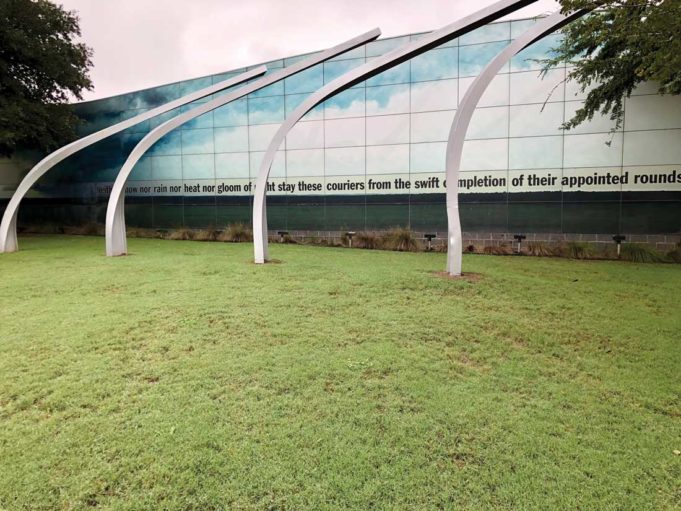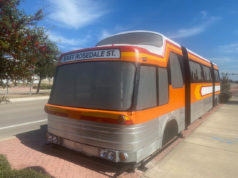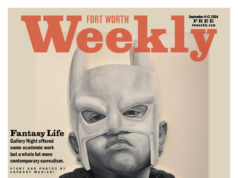The Museum Place Post Office at the edge of the Cultural District is the last structure visitors may think to visit for its architectural significance –– if they could even find it. But like the Amon Carter Museum of American Art, the Kimbell Art Museum, and the Modern Art Museum of Fort Worth, the federal building was designed by architects who made an indelible mark on modern architecture. Built in 2009, the 5,900-foot structure is the only North Texas building designed by Venturi Scott Brown and Associates, run by the husband and wife duo of Robert Venturi, who died September 18, and Denise Scott Brown, both of Philadelphia.
Venturi died just as national architects, critics, and preservationists are rallying against a proposed addition to the Museum of Contemporary Art in San Diego by architect Annabelle Selldorf. They alleged in an open letter to the Los Angeles Times that the addition erases VSBA’s signature entryway. Scott Brown may have retired, but her influence is not waning anytime soon. A portion of her nearly 11,000 photographs have appeared in exhibitions in London and Venice and are the subject of an exhibition in Vienna and a forthcoming book as well.
The post office has not drawn the praise or controversy like in San Diego. Though it was built nearly a decade ago, it has received barely any media attention in its decade-long existence. With Venturi’s recent death, now’s as good a time as any to consider its understated brilliance. Sitting at the four-way intersection of Bailey Street, Camp Bowie Boulevard, University Drive, and West 7th Street, it is also not easy to access. From the north end, the triangular building looks like a public art project, featuring a mural of a developing thunderstorm beneath the unofficial post office motto (“Neither rain nor snow nor heat nor gloom of night stay these couriers from the swift competition of their appointed rounds”) sitting behind four bent billboard beams. They are the only remnants of the 2000 tornado that ravaged parts of downtown and the Cultural District.
The south wall is made of floor-to-ceiling glass framed by six bold blue pillars showing the interior. It looks like any other post office on in the inside and uses the colors (blue and white) and architectural features traditionally affiliated with post offices (brick-and-mortar and glass). But not every post office sits across from an iconic museum district and an array of cheap developments.
It was one of Venturi and Scott Brown’s last projects before both retired in 2012. While their firm received six Texas commissions over the decades, only three materialized: the post office, the eccentric Houston Children’s Museum, and the master plan for the Strand Historic District in Galveston. The Museum of Fine Arts in Houston selected the firm for a master plan, but it never materialized, according to a spokesperson for the museum. Two other projects in Austin –– the Republic Square District and what’s formerly known as the Austin Museum of Art –– were abandoned or built but radically altered.
“We have loved the problem of designing for a small but important public structure in a big Texan environment,” they said of the project.
Venturi believed in the experience of the “ordinary” building. The post office works in the location because it blends in with not just the museums but the strip malls they inspired.
Venturi was a well-known architectural theorist, sort of a radical for his time.
In his first book, 1966’s Complexity and Contradiction in Architecture, he urged architects to liberate themselves of the modernist dogma. He was already known at that point for fiddling with architectural norms. But he also asked architects to embrace the “architecture of the everyday landscape.” Two great local examples of the types of work Venturi questioned are Paul Rudolph’s City Center towers downtown and TCU’s Sid Richardson Building. To Venturi, architects such as Rudolph believed a barebones design was the best design, even if it is ahistorical.
In the 1972 book Learning from Las Vegas, coauthors Venturi, Scott Brown, and colleague Steven Izenour celebrated the neon signs and roadside attractions of Las Vegas. To many, the signs and other ornate, glitzy features were tacky and childlike. To Venturi, they defined a sense of place.
Venturi refused to call his practice “postmodern,” but the term stuck. Some critics argue his ideas led to the modern day suburban shopping center and megachurch, both staples of Fort Worth. But he also influenced Tadao Ando, Philip Johnson, Louis I. Kahn, a fellow Philadelphian, and Renzo Piano, the four starchitects whose museums form the Cultural District.
As Venturi said in a 1973 interview, “We say our buildings are ‘ordinary.’ Other people have said they are ugly and ordinary. But, of course, our buildings in another sense are extraordinary, extra-ordinary. Although they look ordinary, they are not ordinary at all but are, we hope, very sophisticated architecture designed very carefully, from each square inch to the total proportions of the building.”
The post office was part of a larger plan to revitalize the West 7th corridor and reshape the surrounding Linwood neighborhood. The results are mixed. The developments –– Crockett Row at West 7th, Montgomery Plaza, Seventh Street Station, and Left Bank –– have the charm of the Trinity Commons shopping center on South Hulen Street but with more of a street presence.
The post office is the only inarguably attractive building to come out of the revitalization efforts. It is a fitting a gateway to the Museum Place, for which the post office is named. Organized and sleek, the collection of multistory mixed-use buildings features an under-appreciated “Modern Flatiron,” a glass-and-brick structure with punched-outward windows. Blue Sushi, with its eccentric interior that includes a bomb casing, large televisions, and high ceilings, is the ground-floor tenant. Across the street is the eight-story One Museum Place, with ritzy tenants like Eddie V’s Prime Seafood and retailer Domain XIV below offices and condominiums. The building wraps around the parking garage. If anything is the opposite of the developments across West 7th, it is Museum Place.
Museum Place is one of many developments to emerge after the 2000 tornado and also the most elegant. While Venturi and Scott Brown likely did not anticipate or even consider the area’s rapid transformation into a highly popular entertainment district, the duo had seen the types of similar shopping centers, apartment buildings, and urban storefronts that now dot West 7th in other cities already. In fact, some critics argue that Venturi’s theories legitimized a national trend of sprawling, bland developments.
The post office’s most spectacular quality is in uniting Venturi’s and Scott Brown’s architectural legacies. From the West 7th strip centers to the crown jewels in the Cultural District, the post office is a testament to Venturi and Scott Brown’s mixed legacy when it comes to modern architecture and the creation of a sprawling city like Fort Worth.












